The Most Important Social Media Trends for 2023
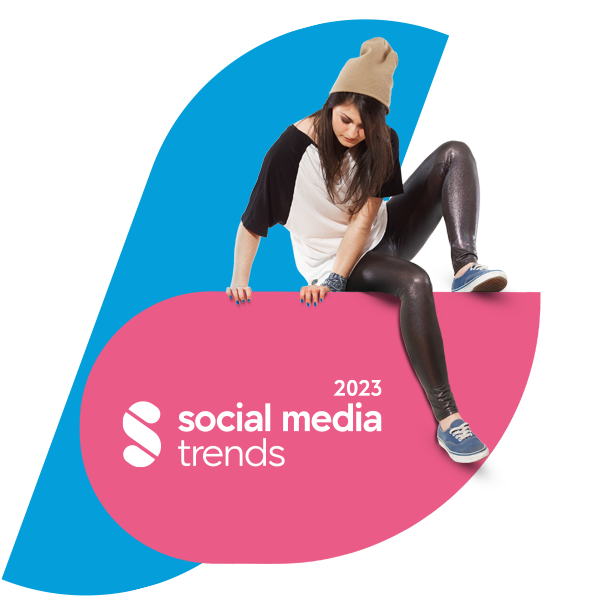
1 . TikTok will take over the world
In our social media trends for 2022, we predicted TikTok would become the most important social network for marketing and we weren’t wrong.
But this year, we’re taking our prediction one giant step further.
A host of new feature releases in 2022 suggest that TikTok doesn’t just want to be the number one social network for marketers. It wants to be the number one social network, period.
TikTok, long known for innovation (its fresh video format was the inspiration for Meta’s Reels and YouTube Shorts, after all), has released at least 7 features this year directly inspired by other social media channels:
A super app is an all-in-one app that includes social media, messaging, services, payments, and basically anything else you would normally do on the internet.
TikTok is making moves into the non-digital world as well. Rumors are swirling that the Chinese-owned company is building fulfillment centers in Seattle and Los Angeles in an attempt to take on Amazon in the ecommerce business.
But will all these big bets be successful? All signs point to yes, mostly.
While TikTok continues to grow its user base (1.023 billion active users and counting as of Q3 2022), it’s also consistently the #1 app in terms of time spent and overall positive sentiment.
- Users spend 95 minutes per day on TikTok (#1)
- Users spend 23.6 hours per month on TikTok (#1)
- 78.6% of internet users use TikTok to look for funny or entertaining content (#1)

Also, according to Google Trends, interest in TikTok Ads (which is a good indicator of business interest in the platform) has increased by 1,125% since 2020.
All this interest is for good reason. TikTok ads revenue is growing so fast it’s set to match YouTube’s ad revenue by 2024. Though Google and Meta are still the biggest companies by far in the digital ad space, that’s no joke for an internationally-owned social media company.
What does this all mean for businesses? Well, if your business isn’t on TikTok yet, this is your sign to get on it, now.
To-do list
- Grab an account handle for your brand
- Explore TikTok so you can start feeling fluent on the platform and find some ideas
- Sketch out the basics of your TikTok marketing strategy
- Use a social media management tool like Hootsuite to easily schedule your TikToks, moderate comments, and measure your success on the platform from one handy dashboard.
- Start exploring TikTok ads
2. The only new app that will matter will be BeReal
BeReal is a photo-sharing app that prompts users to post one unfiltered, unedited photo per day to a select group of friends. Photos taken outside of the two-minute time frame say how many minutes late they were posted.
The network launched in late 2019, but its popularity exploded in 2022. As of October 2022, it’s the top social networking app on the App Store and has been installed roughly 29.5 million times.
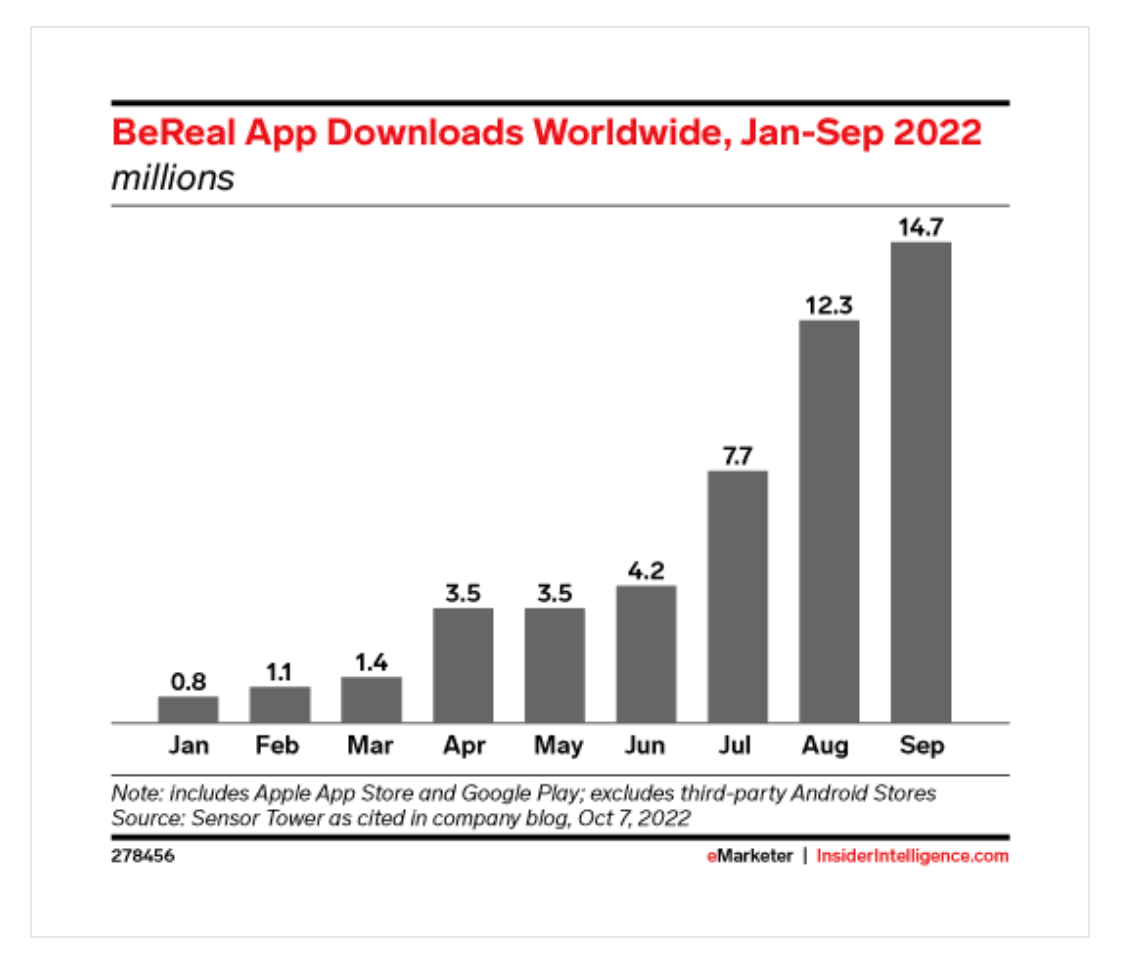
Google Trends also shows that global searches for “What is BeReal” and “BeReal app” exploded mid-year in 2022.
Users skew female and young. The majority are below 25.
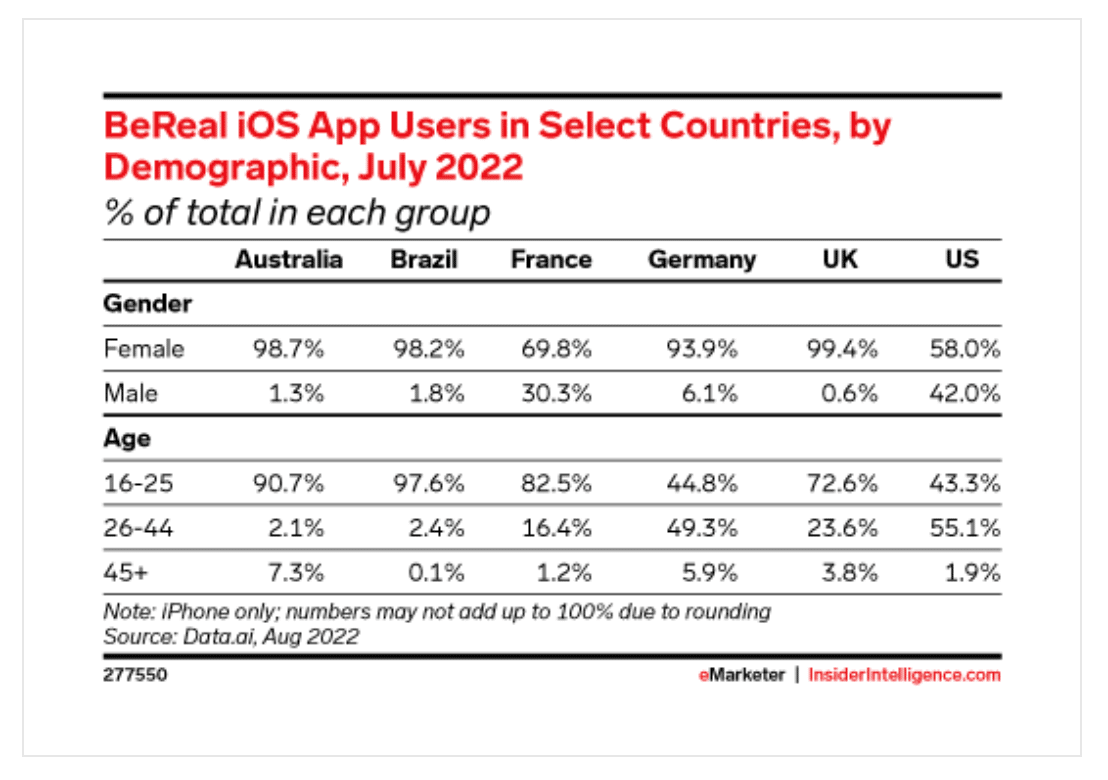
The app doesn’t have ads or features for businesses yet, which many say is part of the appeal.
BeReal gives the feeling of the early days of social media when users mainly posted photos to show their friends what they were up to — before it became the highly curated, ad-heavy space it is today.
Even BeReal’s official communications sound like your best-friend texting you. After a large outage on their app, the company simply tweeted “all good now.” This is the opposite of the highly professional communications strategies of other major social networks.
Speaking of outages, the surge in popularity seems to have caught the company unaware. Glitches and outages are frequent (with most users opening the app and posting pictures at the exact same time) and threaten to hinder the app’s growth.
Users are also limited to 500 friends, meaning that your brand’s usual marketing strategy won’t work here.
Despite this, BeReal’s popularity has caught the attention of brands like e.l.f. Cosmetics, Chipotle, and Pacsun. And TikTok and Instagram have both released clones of the dual camera feature (but we don’t know anyone who’s using them yet).
This is why we’re making a big bet on BeReal’s importance in 2023. Even if the app doesn’t survive the year, its impact is already undeniable.
This is what Gen Z wants from social media: unfiltered, uncurated content that doesn’t ask you to buy anything or make you feel bad about your life. It’s a fun place to be. And at the end of the day, that’s all that matters.
To-do list
Time will tell if BeReal caves to the pressure to monetize for business. But for now, just make sure you’re paying attention.
- Make a profile and get familiar with the platform
- Experiment with the dual camera feature on a platform your brand already has a presence on (i.e., Instagram or TikTok) to see if it gets any traction with your audience
3. You will still have to make Reels
Instagram HQ seemed a wee bit chaotic in 2022, with multiple feature updates and Kardashian-inspired backpedaling. But, in our opinion, Instagram is still the reining platform for brands.
Why?
- Instagram has 1.5 billion daily active users (and 2+ billion monthly)
- Reels grew by 220 million users between July and October 2022.
- 62% of Instagram users say they use it to research brands and products (Facebook takes 2nd place with 55%)
- It’s the preferred app among 16- to 24-year-olds (yes, it’s still beating TikTok)
- Its ad platform and in-app shopping tools have been around for years, meaning you’re not gambling for ROI
Plus, Instagram is still pushing video hard. For instance, all Instagram videos are Reels now, and Reels are heavily prioritized by the recommendation algorithm. For marketers, this means that posting Instagram Reels are the best way to get in front of new eyeballs on the platform.
Google Trends shows interest in Reels reaching all time highs after Adam Mosseri’s announcement that all videos on Instagram would be Reels (in July 2022).
Fortunately, with the rise of TikTok, YouTube Shorts, and Amazon Video Shorts (??!), once you’ve made a short video, cross-posting is easy (though not officially encouraged). Just make sure you scrub off those logos and watermarks!
To-do list
- Open up your Reels tab and get comfortable with short-form video, if you aren’t fluent already
- Differentiate between making videos that are evergreen with original audio, versus more viral-style videos that rely on trending audio, replies, stitches, etc.
- For your original videos, learn how to download TikToks and Instagram Reels without watermarks so that you can cross-post them to all the platforms you like
- For viral-style videos you’ll need to keep an eye on the trends, and you probably won’t be able to cross-post as easily
- Save yourself time and headaches by scheduling all your videos in advance with Hootsuite
4. Clubhouse will die and social audio will get more niche
Every now and then, a new social media app comes along that changes the way we create and consume content. Snapchat did it with disappearing content, then TikTok did it with short-form videos. In 2020, Clubhouse did it (or was supposed to do it) with social audio.
Once hailed as “the next big thing” in social media, Clubhouse is now competing against a new wave of copycat audio-based platforms. In fact, when was the last time you heard anyone mention Clubhouse?
Still racking your brain? Us too.
Nick Martin, Hootsuite’s Social Engagement Specialist (whom we interviewed about Clubhouse when it first came out) puts it nicely:
“Clubhouse showed that social audio was a viable way to share content and then the bigger networks said “thank you very much” and made their copycat features. Twitter Spaces rules the roost now and while Clubhouse is still around, it’s not people’s first choice.”
According to Martin, Twitter Spaces has been more successful among businesses because it’s in an app they already use, with an audience they’ve already built. At this point in social media history, it’s just too big of an ask to build a following from scratch with an expensive media format on a brand-new app — unless that app is TikTok (see social media trend #1).
Downloads have slowed for Clubhouse since its original success in early 2021.

Another worrying signal? Some top Clubhouse executives are leaving the company.
For instance, Aarthi Ramamurthy, former Head of International and co-host of “The Good Time Show,” not only left Clubhouse, she moved her show to YouTube. Not a great sign of confidence.
Social audio itself is still very much an experimental space, with no clear winner:
- Spotify Live (once Greenrooms), recently stopped funding their creator fund — an attempt to lure creators away from Clubhouse — saying simply, “We plan to shift toward other initiatives for live creators”
- Facebook Live Audio Rooms has decided to “simplify” by folding the feature into Facebook Live
- Twitter has reportedly shifted resources away from Spaces;
- Amazon created Amp, but then laid off 150 of the people working on it
And then there’s the data showing that social audio isn’t really resonating with users.
- Only 2% of US teens and adults used Twitter Spaces as of January 2022
- 1% each used Clubhouse and Spotify Live
Though the data looks grim, some believe social audio might thrive with more niche audiences. For example, Twitter’s Super Follows Spaces allows creators to host audio events exclusively for their paid subscribers. And Discord, the platform known for its niche communities, recently built its own social audio feature, Stage Channels.
To-do list
- Unless you’re trying to reach an extremely niche audience, hold off on investing in a social audio strategy
- If you’re a creator, explore the direct monetization possibilities offered by Twitter’s Super Follows
5. LinkedIn will be about much more than jobs
Have you noticed your LinkedIn feed filling up with more and more personal posts lately? The kind of content you would normally expect to see on your Facebook feed?
You’re not alone. From CEOs crying to overwhelmed parents posting photos of their kids, to breastfeeding advice, the platform is remarkably more personal than it used to be. Some people are even using the platform to find dates. Why?
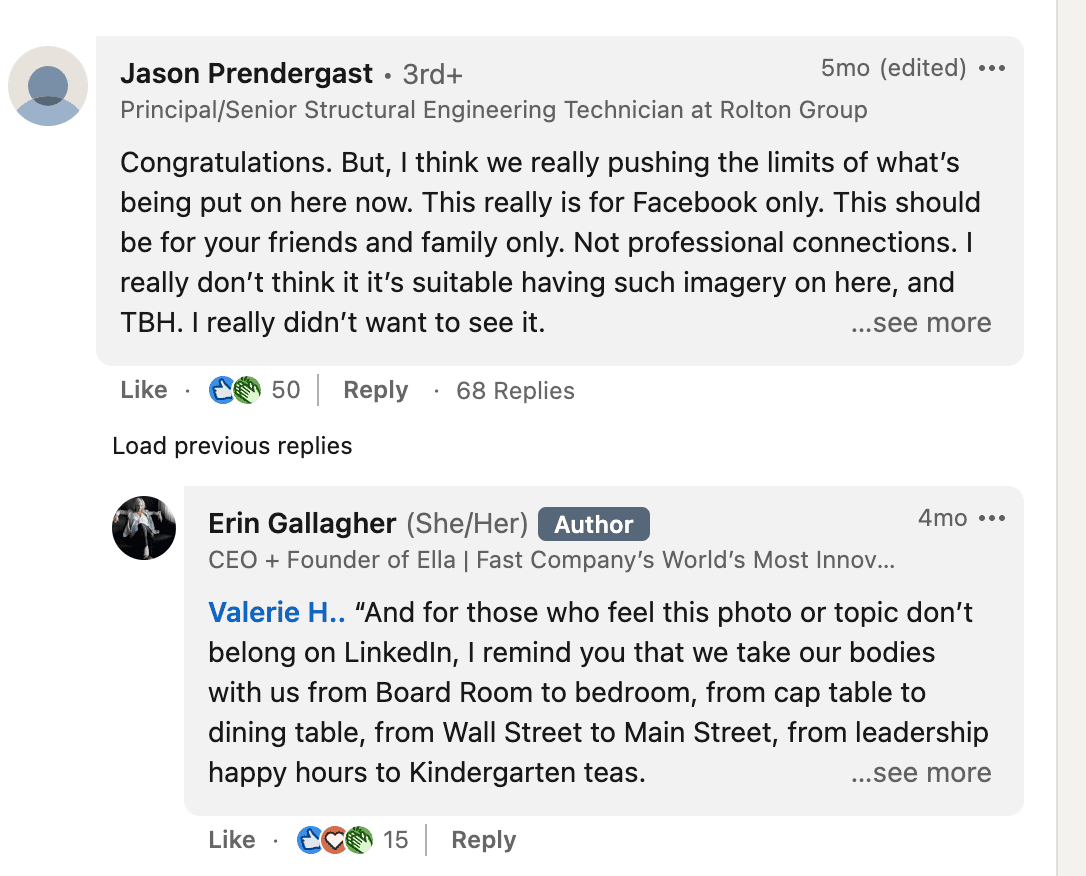
A viral post about a CEO’s difficulty with breastfeeding sparks debate in the comments about whether it would be better suited to Facebook.
Has the LinkedIn algorithm changed to favor more personal posts? Or has the pandemic erased the boundaries between our personal and professional lives?
Could it be that trust in Facebook, where we would normally post this kind of content, is at an all-time low, while trust in LinkedIn remains high – along with engagement rates? Perhaps most of the other social networks feel so oversaturated that LinkedIn seems like an opportunity to grab attention?

In 2021 we noticed that similar to Twitter, LinkedIn posts without links outperformed those with links, suggesting an algorithm change favoring content that entices people to stay on the platform longer. This still seems to be the case in 2022, with most viral posts containing a mix of long-form personal storytelling and photos (almost like blog posts) vs. links to content on other websites.
Whatever the reason, it doesn’t seem like this markedly less “professional” trend is going anywhere soon.
- LinkedIn invested $25 million in a Creator Fund, paying 100 creators $15,000 each to “share content, spark conversations, and build community.” (The goal is notably similar to ones held by Instagram and Facebook, neither of which are explicitly professional platforms.)
- It also launched LinkedIn Audio Events (a Clubhouse clone) and a podcast network.
- It released carousels and reaction buttons — both originally found on Facebook and Instagram.
To-do list
Don’t worry. We’re not going to suggest you slide into the DMs of a potential soulmate on LinkedIn. For now, experiment with the following:
- Change up your posting strategy to include some linkless posts, such as words of encouragement, cheesy jokes, or short personal anecdotes.
- If you’re dabbling in thought leadership on the platform, take the opportunity to dig deeper. Help your C-suite execs offer ideas and advice through a personal lens, showing your followers their human side. But keep it genuine and grounded in reality, or else you could risk backlash.
- Consider hiring a ghostwriter to head your LinkedIn content strategy, and write posts that avoid jargon.
- Use Hootsuite to crosspost content you might typically post to Instagram and Facebook. Track if it performs well on LinkedIn.
- Be careful not to overshare. Even though more personal content is trending, it’s still very much a professional app with 6 people getting hired every minute.
6. Gen Z will redefine UGC
User-generated content (UGC) is usually defined as content created by regular people on social media, rather than content made by brands. For example, instead of posting a product shot by a professional photographer, Nike might repost a photo from a happy customer wearing their new Nike kicks.
UGC is great for brands that care about increasing awareness and deepening relationships with their customers. It’s authentic social proof, and it makes the UGC creator feel special, both of which increase brand loyalty.
All that said, it has recently come to our attention that Gen Z understands the term “UGC” in a whole different way: that is, as social media posts produced by freelance marketers or micro-influencers for businesses.
In Gen Z terms, brands pay “UGC creators” to produce content that looks like organic UGC.
Here’s an example:
Unlike traditional influencers, who promote brands using their own channels, UGC creators hand over the content they make for distribution on the brands’ own channels. They are less brand advocates than paid content creators.
We expect that UGC will hold both definitions for a while. But this all points to a larger social media trend: brands outsourcing their social media labor to the creator economy.
Last year, we wrote about the growing importance of influencer partnerships for marketers. And in 2023, businesses (especially large ones) will continue to look for help from social media creators in order to reach their ideal audience.
Hootsuite’s 2023 Trends survey found that 42% of businesses with over 1,000 employees work with creators as compared to only 28% of small businesses (those with less than 100 employees).

Source: Hootsuite Social Trends Report 2023
But there’s a new side to the creator economy to pay attention to: freelance content creators who aren’t necessarily influencers, but who are just really good at social media and sell their services to brands.
This makes sense. Reels and TikToks are growing more popular. And they require a special mix of skills: technical acuity and professional-entertainer-level charisma. Not just anyone can make a watchable Reel or TikTok, believe us.
Further, traditional UGC isn’t as valuable as it once was on social media. Sure, social proof is still important to potential customers, but with the social algorithms pushing videos over photos, it’s not likely that a photo of the shoe I just bought will even make it to many people’s feeds.
Lastly, with budgets for marketing campaigns at risk of cuts (*cough* recession), and businesses turning to cheaper means of content creation, using freelance creators for one-off videos seems like an obvious solution. We only see this social media trend increasing into 2023 and beyond.
To-do list
- Try Fiverr or Upwork to find a freelance UGC content creator (particularly if you need help creating Reels or TikToks) or post a call on your social media feeds
- Use Hootsuite to schedule these Reels and TikToks to go live at the best times
7. Social SEO will replace hashtags
According to Google’s internal research, 40% percent of 18- to 24-year-olds are now using social media as their primary search engine. In September 2022, the New York Times even proclaimed that “For Gen Z, TikTok is the New Search Engine.”
Globally, people of every age group use social media to research brands.
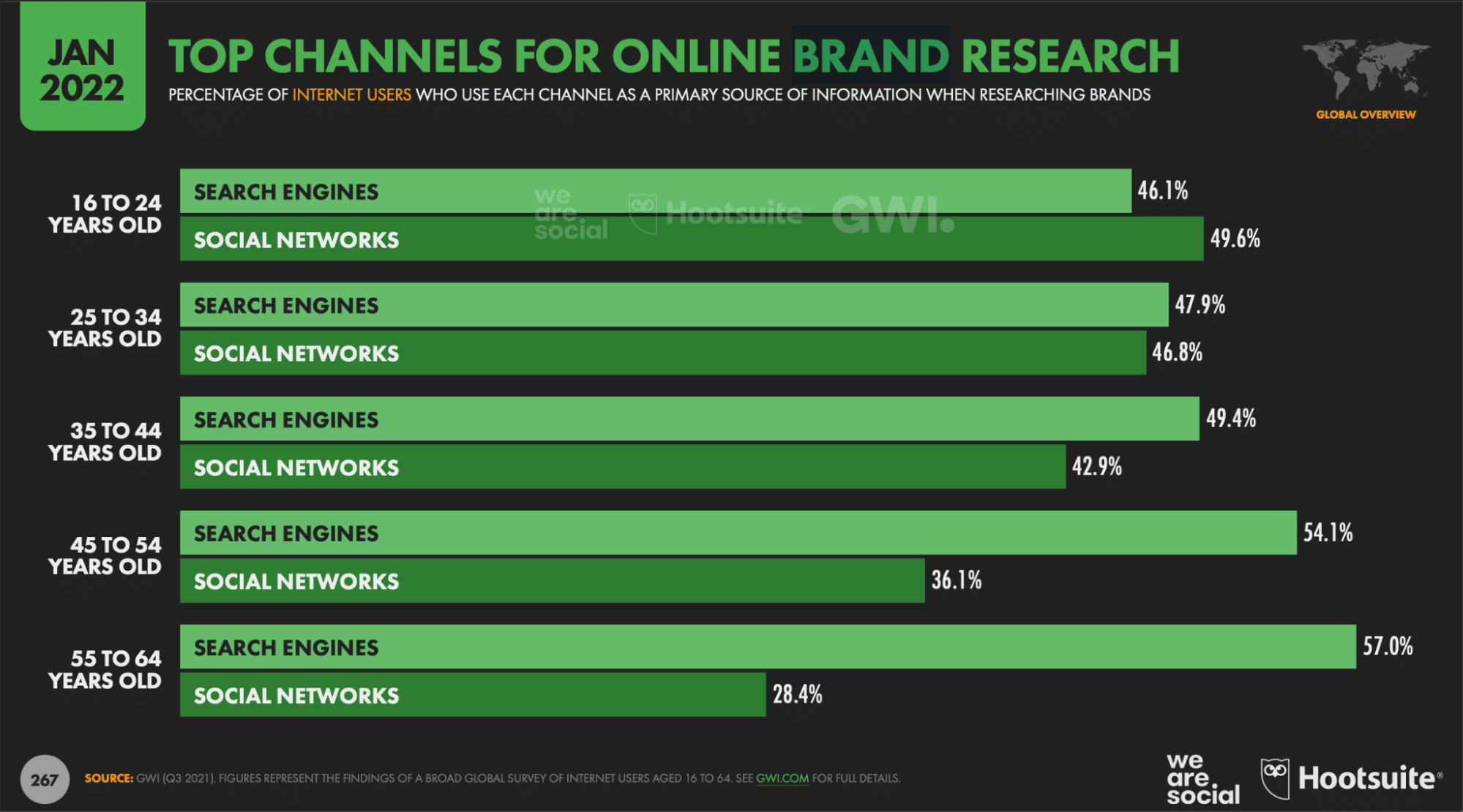
Meanwhile, our own internal research (a.k.a. the test we ran on one of our writer’s Instagram accounts) found that using keyword-optimized captions instead of hashtags increased reach by 30% and doubled engagement.
And on top of that, Hootsuite’s 2023 Trends report found that more internet users aged 16-24 use social media for researching brands they want to buy from than search.
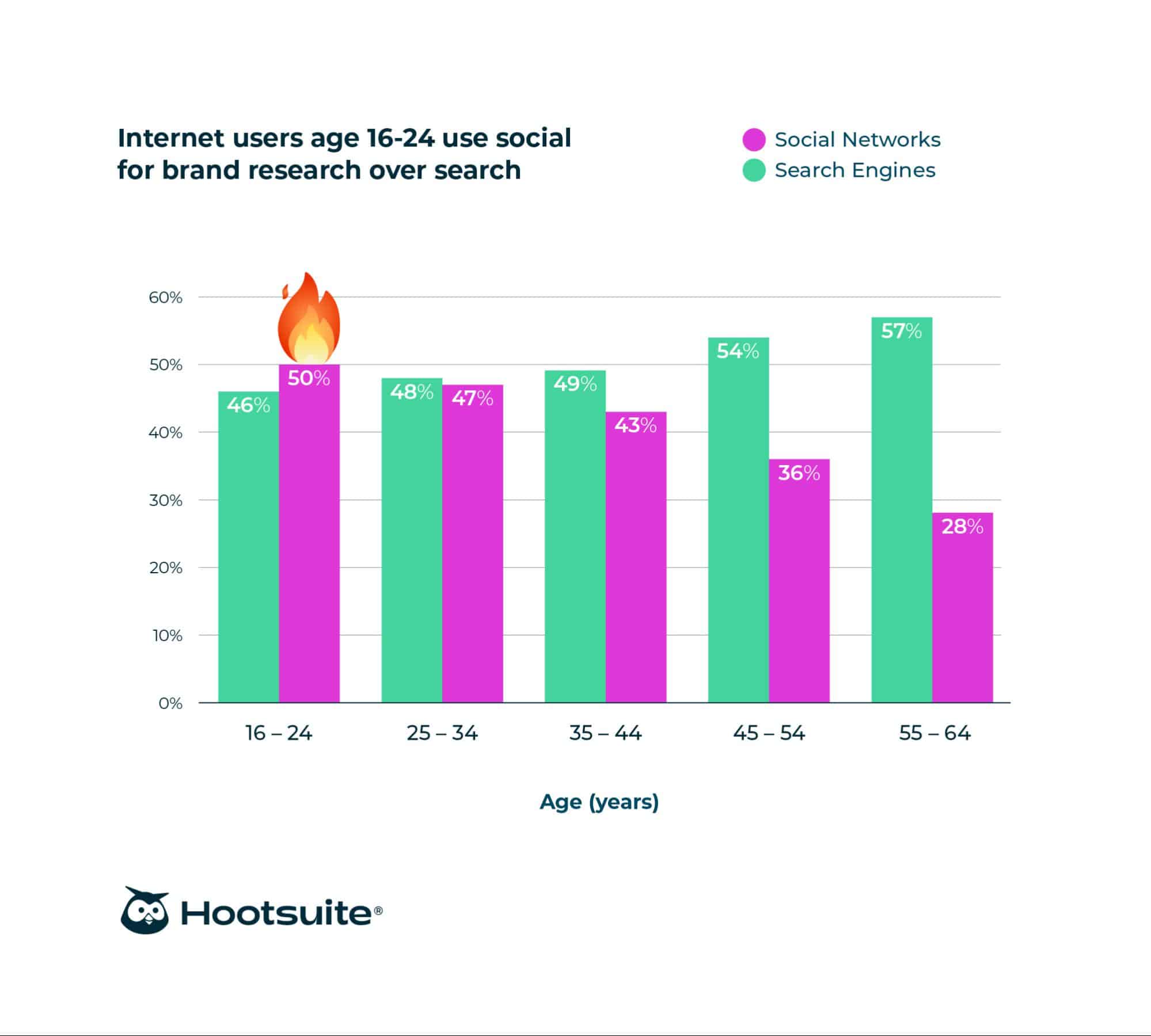
Source: Hootsuite Social Trends Report 2023
So, what does this mean for social media pros?
It’s time to add some keyword research to your social strategy. Rather than slapping hashtags into your copy after a post is finished, use keyword research to inspire you to make content that people are already searching for.
Even if you don’t see a massive search-fueled jump in traffic and engagement, the worst-case scenario is that you get a bunch of ideas for new posts.
Another social search tip? Hootsuite’s Social Media Marketing Lead, Brayden Cohen, says to think about your social media profiles as mini landing pages:
“Search is never going to be dead when it comes to Google. But people’s habits are changing. They’re using social to search for new products. Whereas beforehand, I think people were just coming to social for reviews or getting to know a brand, now they’re going for social to actually buy…The main thing it’s changed for me is my perspective. I treat our social pages like a mini landing page and website. I try to imagine using our social channels as the main point of purchase.”
To-do list
- Read our social SEO blog post to get the basics of keyword research down
- Start incorporating SEO into all you’re doing on social: add keywords to your bio, add alt-text to images, and sprinkle in relevant keywords as you write your captions
- Add SEO to your content strategy: Use SEMrush or Google’s Keyword Planner to choose some relevant keywords and make content that targets those keywords. Then track what happens (preferably with Hootsuite Analytics)
8. Closed captioning will be the default on social video
Since the dawn of time — or at least 2008 when Facebook and YouTube launched their mobile apps — social media users have been scrolling through videos on silent. As many as 85% of social media videos are watched without sound, especially in public places, according to multiple studies. And viewers are 80% more likely to watch a video to completion if it has captions.
Now that short-form video (ok, TikTok) has eaten the internet, in 2023 we predict that captions will be the default for all published video content. For three reasons:
- Accessibility: not just for people watching on the bus, but also for people with hearing impairments
- Engagement: captions keep people watching to the end
- Discoverability: using keywords in captions is a crucial step in optimizing videos for search, increasing the number of people likely to see it
To-do list
- Learn how to add closed captioning to your short-form AND long-form video
- Make sure you’re saying keywords out loud in your video so that they show up in the captions, too
- If you’re on TikTok and pressed for time, try the auto-captioning feature
9. Social commerce will continue to grow, despite confusing signals from networks
Last year, social commerce was one of the biggest social media trends. As sales blasted past $350 billion in China, North American and European marketers scrambled to position themselves to take advantage of a new way to make money directly on social.
But despite its success in China, North American and European consumers have been slower to catch up. Some social networks scaled back on shopping features (particularly ones to do with “live” shopping, which is a less common phenomenon in Western markets):
- Meta shut down its live commerce functionality on Facebook
- Instagram shut down its affiliate product tagging option
- Instagram also removed its Shop tab
- TikTok delayed the launch of live shopping in Europe and the US after a test in the UK failed to meet targets
Does this mean the promising future of social shopping is further off than anticipated?
Maybe.
According to a survey of 10,000 global consumers performed by Accenture, many shoppers still don’t trust the process of buying products through social media.
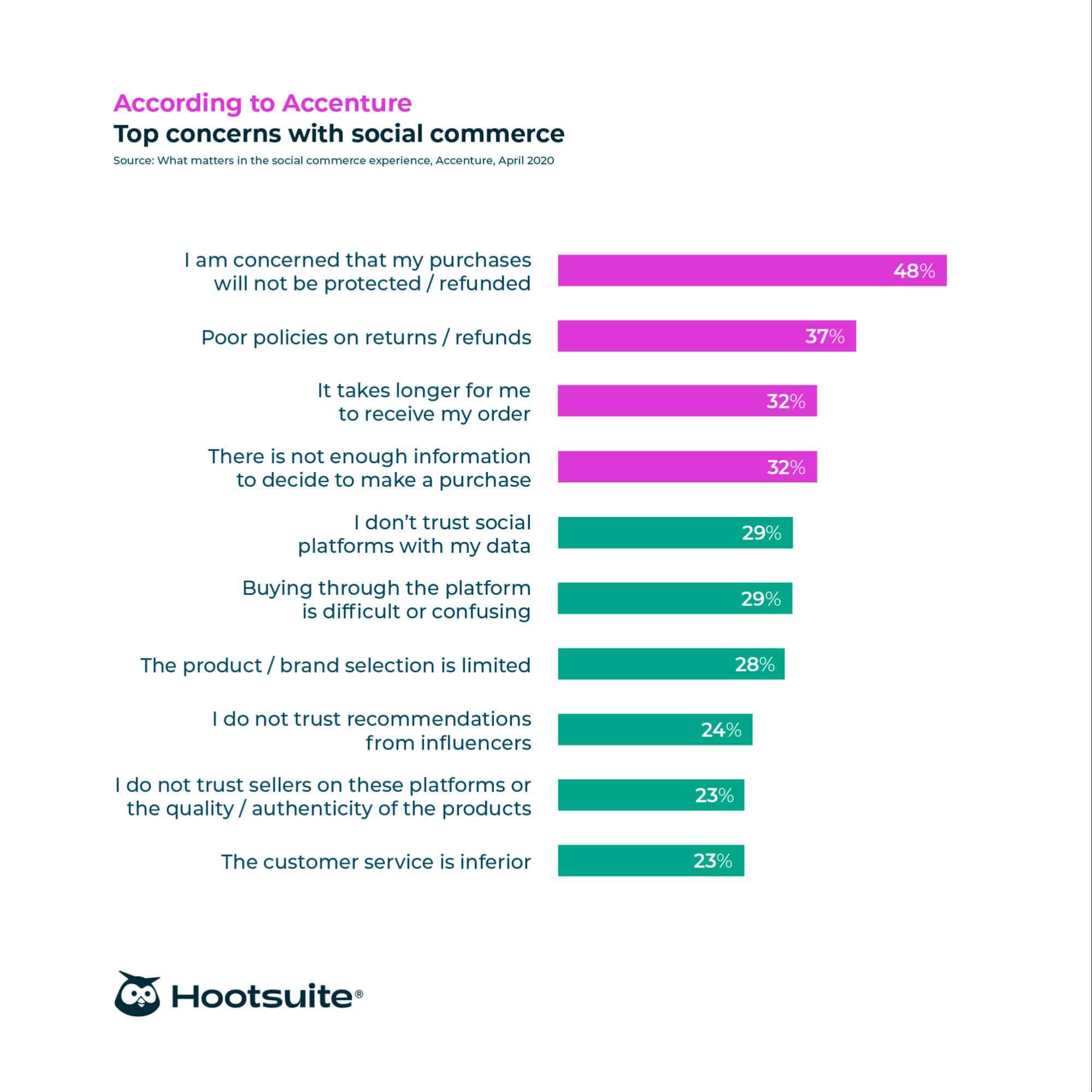
Source: Hootsuite Social Trends Report 2023
Their biggest concern is that their purchases won’t be protected or refunded. They’re also worried about the quality and authenticity of products and sellers on social media. And the third most common concern is not wanting to share financial information with social networks.
Hootsuite’s Trends report asked survey respondents a similar question — what are the greatest barriers for social buyers? — with similar results.
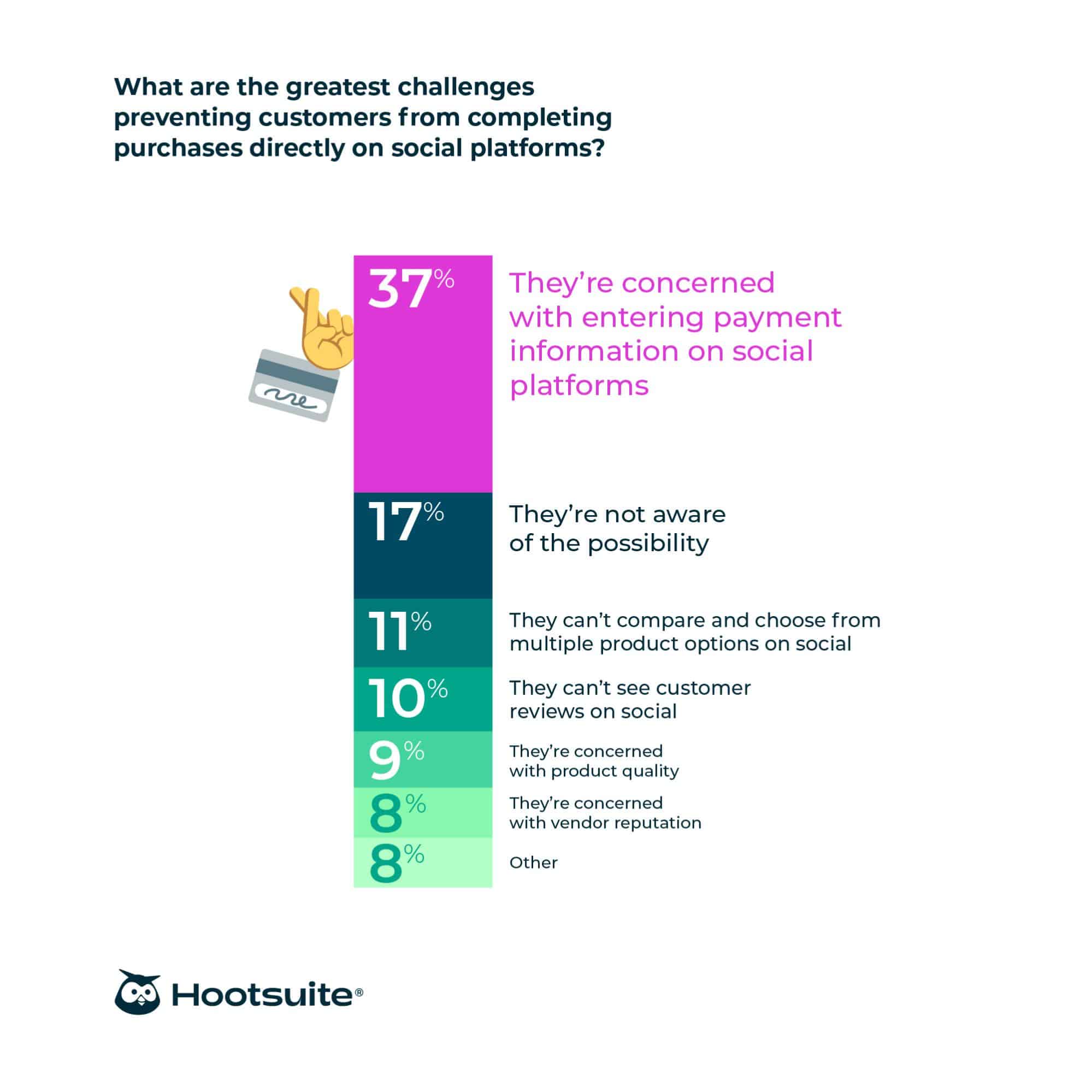
Source: Hootsuite Social Trends Report 2023
Despite these results, eMarketer data forecasts that social commerce is still a huge and growing industry, even in the US.
Though growth in new shoppers has understandably slowed since the pandemic, by the end of 2022, existing consumers will have spent $110 more on purchases made on social in 2022 than in 2021, with most new buyer growth coming from TikTok. This suggests that, despite trust issues, audiences are starting to get used to social media as a shopping channel, using it more than ever before.
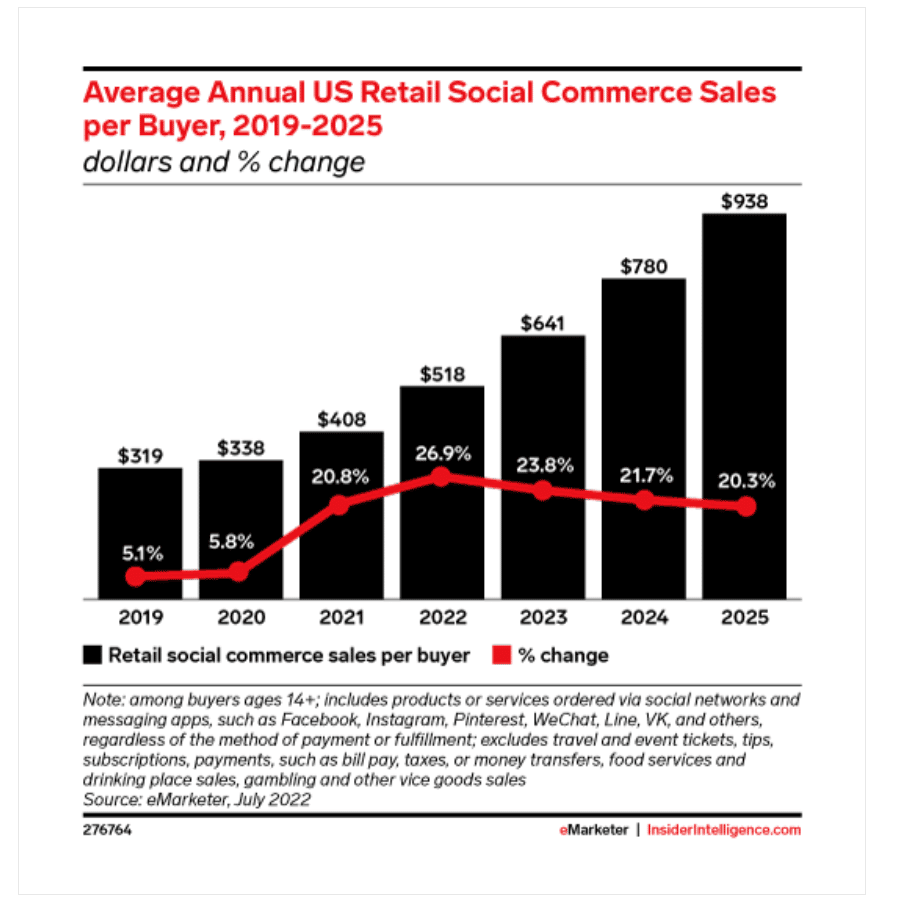
And while the live shopping experience may not have been a hit with Western audiences, it’s not necessarily a signal that social commerce is over. Social commerce takes many forms, including shoppable posts/ads, AR shopping, referrals, and even second-hand marketplaces like Facebook Marketplace, all of which are common tactics used in North America and Europe.
In fact, many believe that Instagram’s removal of its Shop Tab (along with other organic shopping features like live shopping and affiliate links) is an effort to tie social commerce revenue more directly to ads, especially now that “recommended posts” are included in the feed algorithm. That means they want people to buy stuff on their platform, but through paid advertising, because they make more money that way.
To-do list
Retail and ecommerce businesses should still be paying very close attention to social commerce — and Western-focused businesses should be proactive about getting good at it before their competitors do.
- Turn skeptical shoppers into buyers by offering easy returns and refunds, displaying ratings and reviews from other buyers, and keeping buyers notified about the status of their purchases throughout the customer journey.
- Don’t invest in live shopping if your audience is based in North America or Europe. Elsewhere, it’s still worth experimenting with.
- If you’ve got budget, spend it on shoppable Instagram and Facebook Ads.
- If your budget is tight, the biggest opportunities for organic growth in social shopping are on TikTok. Post with the hashtag #TikTokMadeMeBuyIt or wait for the TikTok Shop tab to come to the US.
- Use Hootsuite to save time on customer service by responding to all your social DMs in one dashboard.
10. You will have to tell your millennial coworkers to stop using GIFs
It’s gonna be tough to break it to millennials—especially the ones who are still mourning skinny jeans—but gifs are not only an inefficient technology that is older than the internet, they are … not cool anymore.
Of all the trends on social media this year, this one truly breaks our hearts.
What’s our evidence? Giphy, the search engine of gifs, has declined in value by 200 million USD since its peak in 2016. And according to Giphy itself: “There are indications of an overall decline in gif use due to a general waning of user and content partner interest in gifs… They have fallen out of fashion as a content form, with younger users, in particular, describing gifs as ‘for boomers’ and ‘cringe’.”
Just because reaction gifs are passé doesn’t mean that all animated images are out, however. Using stickers as tools on your Instagram Stories isn’t going anywhere anytime soon (yes, they are technically gifs.) And creating animations to demonstrate how-tos or product flows is still a much more nimble solution than asking someone to commit to a full video, according to Denea Campbell, Hootsuite’s email marketing strategist.
To-do list
- Break it to your elders gently
- Help them get fluent in emoji, instead (although there are boomer-only emojis, too)
- Remember that some gifs are practical and still ok
11. More billionaires will buy more social networks
Of all the social media trends in 2023, this is the one we have the most mixed feelings about.
Social media news in 2022 was a long parade of byzantine sagas as several billionaires set their sights on social. Elon Musk, Peter Thiel, and the artist formerly known as Kanye West have each joined Donald Trump (Truth Social) and Jeff Bezos (who purchased Twitch in 2014) in funding, owning, or attempting to own, their very own social media platforms.
At the time of writing, Elon Musk has officially closed the deal on his 44 billion dollar Twitter purchase. Kanye West has proposed purchasing Parler (a right-wing free-speech social network with only 50k DAUs) in October 2022. And Peter Thiel backed Rumble, a conservative video platform, in 2021.
We predict this trend will only continue in 2023 as social media becomes an increasingly powerful force in society and business, and suspicions about the objectivity of algorithms increase (along with fears of censorship and fake news). We may even see more billionaires create their own social networks, a la former U.S. President Donald Trump.
But this is more unlikely, as Trump’s network has largely failed to gain critical mass, and there is yet to be a successful model of a personality-driven, brand-new social network. Most likely, those with the money to do so will continue to try to grab a controlling slice of more established social networks.
However, if this is the way it’s going to go, we really do hope that Rihanna will buy Snapchat and MacKenzie Scott will pick up Pinterest (and maybe Goodreads while she’s at it).
To-do list
Businesses don’t have a ton of control over which billionaires decide to buy which social media platforms. All you can really do is:
- Keep an eye on the news. New ownership could mean changes for ad revenues, network policies, and algorithms — and you’ll need to be able to explain any sudden drops in performance or shifts in strategy to your boss.
- Continue creating content that resonates with your audience. No algorithm change can get in the way of that (we hope).
- Make sure your followers are following you on all your social channels (just in case one of them tanks overnight due to the ego-driven decisions of a new owner).
- Keep educating yourself and your Uncle Steve about misinformation and critical thinking.
- Take care of your mental health and protect yourself from trolls (here are our best tips for social media pros).